
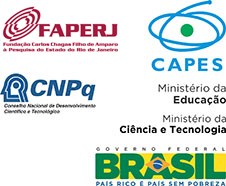
Artigos no Prelo
Artigos
Caracterização Física, Química e Mecânica de Biocompósitos de Polipropileno com Fibras de Euterpe precatoria, Paullinia cupana var. sorbilis (Mart.) ducke e Astrocaryum aculeatum
Dorian L. Oliveira; Wamber B. Souza* ; Roberta L. S. Bernardino; Genilson P. Santana; Flávio A. Freitas
; Roberta L. S. Bernardino; Genilson P. Santana; Flávio A. Freitas  ; Antonio C. Kieling
; Antonio C. Kieling  ; Sérgio Duvoisin Junior
; Sérgio Duvoisin Junior  ; Cledson R. Souza; Silma S. Barros
; Cledson R. Souza; Silma S. Barros

The industrial application of Amazonian fibers in plastic production demonstrates a sustainable fusion of nature's resources.
http://dx.doi.org/10.21577/1984-6835.20250061
Magadiítas no Cenário Global de Patentes: uma Análise de Prospecção Tecnológica Recente (2020-2025) com Base na Classificação Internacional de Patentes
Carlos Wesllem da S. Lobo; Davi Ariel B. Cirqueira; Cícero Wellington B. Bezerra; Tiago G. dos Santos*

Magadiite, a lamellar-structured silicate, has significant technological and scientific potential in the global patent landscape.
http://dx.doi.org/10.21577/1984-6835.20250060
Análise Fitoquímica Preliminar e Avaliação da Atividade Analgésica de Extratos Hidroalcoólicos de Malvaviscus arboreus e Hibiscus tiliaceus (Malvaceae)
Rodolfo G. A. V. Pedroso; Aurea Echevarria* ; Marcia C. C. Oliveira; Miriam E.C. Faria
; Marcia C. C. Oliveira; Miriam E.C. Faria  ; Bruno G. Marinho*
; Bruno G. Marinho*

The hydroalcoholic extract of Malvaviscus arboreus and Hibiscus tiliaceus exhibited antinociceptive effects in chemical and thermal simulation models.
http://dx.doi.org/10.21577/1984-6835.20250055
Aproveitamento do Resíduo de Etileno Acetato de Vinila (EVA) como Meio Suporte em Filtro Anaeróbio para Tratamento da Água Residuária da Suinocultura
Janiny S. Silva; Matheus A. Moura; Rennan N. de Franca  ; Alexilda O. Souza
; Alexilda O. Souza  ; Danilo J. Leão
; Danilo J. Leão  ; Flavia M. Barros*
; Flavia M. Barros*
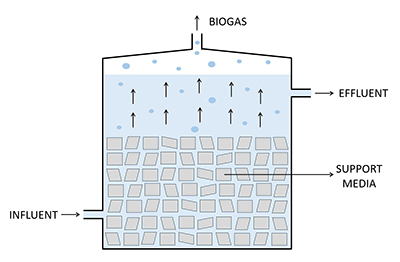
Upflow anaerobic filter filled with Ethylene Vinyl Acetate (EVA) waste for the treatment of Swine Wastewater (ARS).
http://dx.doi.org/10.21577/1984-6835.20250049
Compósito Flutuante e Magnético à Base de FeMnO3/ACC: Um Adsorvente Eficiente para Remoção de Corantes Tóxicos em Meio Aquoso
Luana P. G. Ferreira  ; Guilherme O. Siqueira
; Guilherme O. Siqueira  ; Alley Michael S. Procopio
; Alley Michael S. Procopio  ; Victor de A. A. Oliveira
; Victor de A. A. Oliveira  ; Fabrício V. de Andrade*
; Fabrício V. de Andrade*
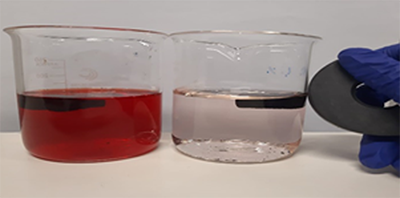
A magnetic and floating composite capable of adsorbing organic contaminants in an aqueous medium.
http://dx.doi.org/10.21577/1984-6835.20250048
Ânodo Contendo Catalisadores de Óxido de Níquel e Molibdênio para Reforma de Etanol em Células a Combustível de Óxido Sólido
Welerson J. Lima  ; Tulio Matencio
; Tulio Matencio  ; Rosana Z. Domingues
; Rosana Z. Domingues  ; Thais O. Ferreira; Gustavo H. M. Gomes
; Thais O. Ferreira; Gustavo H. M. Gomes  ; Nelcy D. S. Mohallem*
; Nelcy D. S. Mohallem*
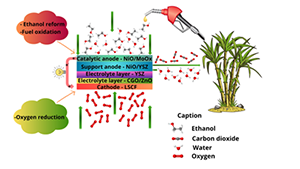
The CO₂ generated by SOFC from ethanol reforming is incorporated by sugarcane during its development. Therefore, the use of this technology does not increase the concentration of carbon dioxide in the atmosphere.
http://dx.doi.org/10.21577/1984-6835.20250047
Análise Comparativa entre Água Sintética à Base de Caulim e Substâncias Húmicas e Água Natural Superficial em Ensaios de Coagulação-Floculação
Diego Gouveia Marques*  ; Janaína de Melo Franco Domingos; Valquíria Campos
; Janaína de Melo Franco Domingos; Valquíria Campos
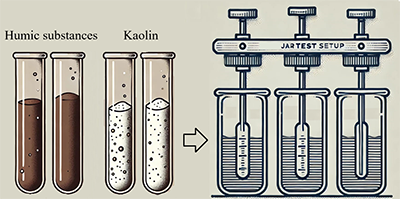
A synthetic water based on kaolin and humic substances was evaluated as a substitute for natural surface water in coagulation-flocculation tests, aiming to provide standardized and representative samples for experiments with a large number of samples.
http://dx.doi.org/10.21577/1984-6835.20250050
Capacidade de Estocagem de Carbono e Nitrogênio em Solos Antrópicos e Não Antrópicos sob Florestas Secundárias no Estado do Amazonas
Ricardo Soares* ; David Vilas Boas de Campos
; David Vilas Boas de Campos  ; Beata Emoke Madari
; Beata Emoke Madari  ; Pedro Luíz de Oliveira de Almeida Machado
; Pedro Luíz de Oliveira de Almeida Machado  ; John Edmund Lewis Maddock
; John Edmund Lewis Maddock 
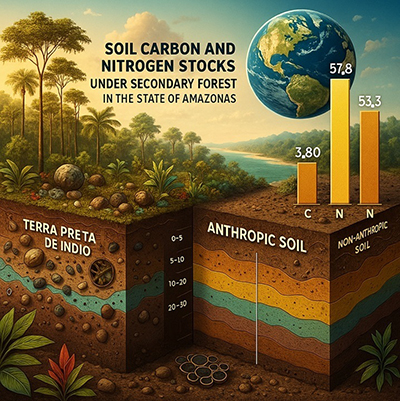
Amazonian Dark Earths (Anthropic Soils) are enriched with black carbon, demonstrating superior carbon storage capacity compared to non-anthropic soils.
http://dx.doi.org/10.21577/1984-6835.20250046
Caracterização Energética dos Resíduos da Agroindústria do Milho em um Protótipo de Gaseificação Multizona
Jorge Mario Mendoza Fandiño  ; Stiven Javier Sofán German; Daniel Esteban López García; Arnold Martinez Guarín; Jesus David Rhenals Julio
; Stiven Javier Sofán German; Daniel Esteban López García; Arnold Martinez Guarín; Jesus David Rhenals Julio
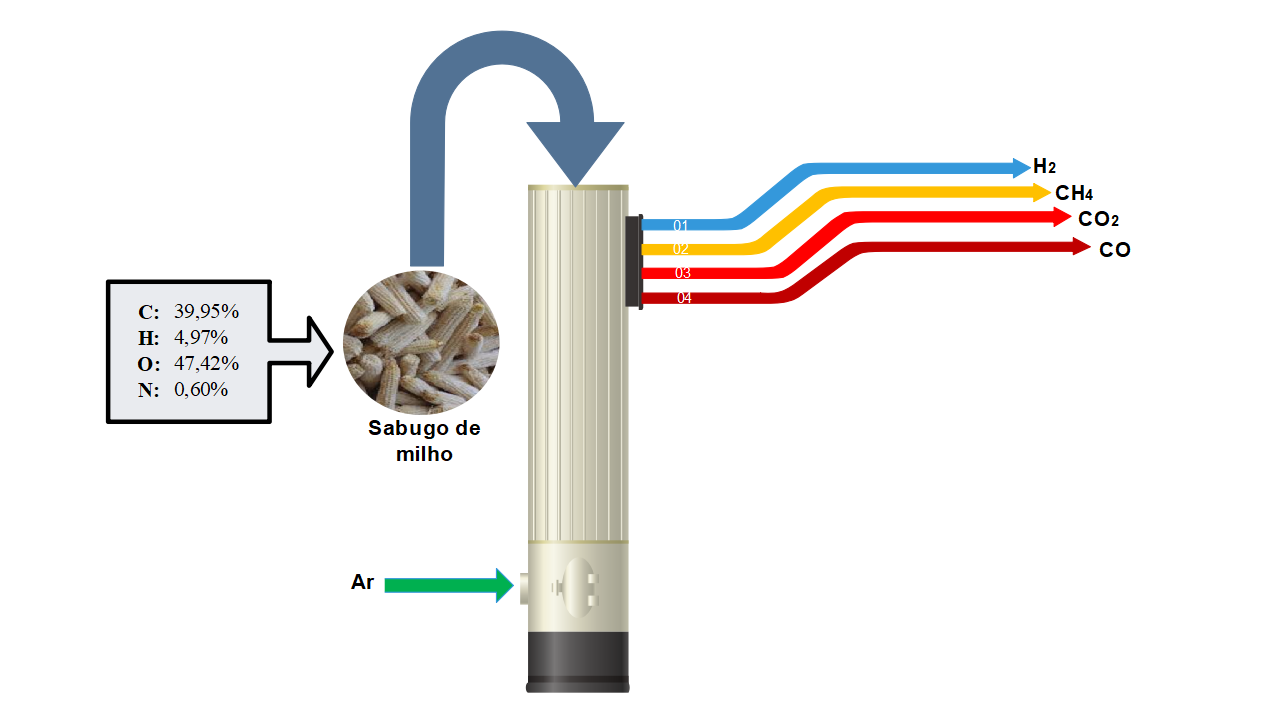
http://dx.doi.org/10.21577/1984-6835.20210099
Reviews
Nitroprussiato e Outros Complexos Cianoferratos: Uma Breve Revisão sobre Aspectos da Atividade Biológica
Juan Camilo Rojas Sterling  ; Maria Isabella Zachi Soares
; Maria Isabella Zachi Soares  ; Gian Vitor Rodrigues
; Gian Vitor Rodrigues  ; Victoria Carolina Romero Colmenares; Diego Batista Felix
; Victoria Carolina Romero Colmenares; Diego Batista Felix  ; Emanuela da Conceição
; Emanuela da Conceição  ; Marilândia Ananias
; Marilândia Ananias  ; José Clayston Melo Pereira*
; José Clayston Melo Pereira*
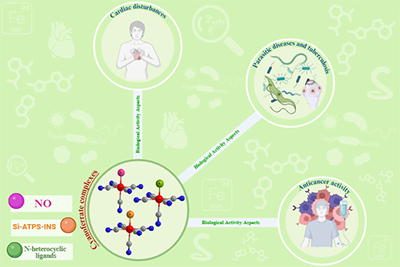
Cyanoferrates and their pharmacological applications include hypotensive action, anticancer properties, antituberculosis potential, and antiparasitic effects.
http://dx.doi.org/10.21577/1984-6835.20250053
Fitoconstituintes e Atividades Biológicas do Gênero Vitex no Brasil: Uma Revisão
Juliene A. S. Cardoso*  ; Lucas G. P. Silva
; Lucas G. P. Silva  ; Juliana Aljahara
; Juliana Aljahara  ; Alan B. Ribeiro
; Alan B. Ribeiro
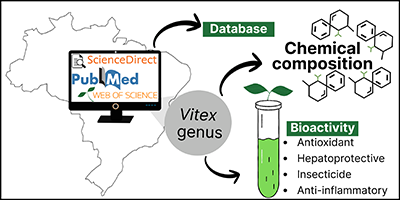
Chemical composition and biological properties of Vitex species native to Brazil.
http://dx.doi.org/10.21577/1984-6835.20250054
As Bactérias Fofocam? Quorum Sensing: A 'Fofoca' Química entre Espécies
Ana Luiza Suhet  ; Jacqueline Santos Cruz
; Jacqueline Santos Cruz  ; Lidilhone Hamerski*
; Lidilhone Hamerski*

Quorum sensing (QS) is a cell-to-cell communication system used by bacteria to coordinate behaviours in response to changes in population density.
http://dx.doi.org/10.21577/1984-6835.20250051
Educação
Alerta de Spoilers: A Química Como Você Não Vê nas Séries de TV
Valdinei S. de Souza* ; Dalila dos S. Monteiro; Jeferson do R. Almeida
; Dalila dos S. Monteiro; Jeferson do R. Almeida  ; Marciana B. da Silva
; Marciana B. da Silva
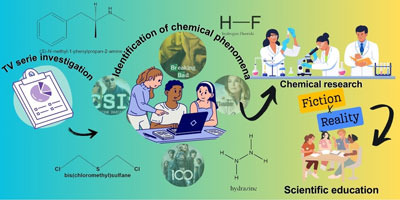
TV series mentioned in the research are used to identify chemical phenomena and the selected contents are used for the teaching of chemistry.
http://dx.doi.org/10.21577/1984-6835.20250065
Discussões sobre Resistências Femininas e Rupturas da Estrutura Capitalista na Formação Docente em Ciências/Química
Gustavo Augusto Assis Faustino  ; Keythy Ravena Batista Nascimento
; Keythy Ravena Batista Nascimento  ; Camilla Ferreira Alves
; Camilla Ferreira Alves  ; Itallo Junior Chaves dos Santos
; Itallo Junior Chaves dos Santos  ; Marysson Jonas Rodrigues Camargo
; Marysson Jonas Rodrigues Camargo  ; Anna Maria Canavarro Benite*
; Anna Maria Canavarro Benite*
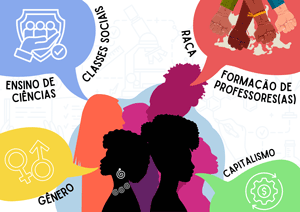
The image shows the training of science/chemistry teachers by gender, class and race.
http://dx.doi.org/10.21577/1984-6835.20250063
Era Vargas e Ensino de Química: as Modificações nos Conteúdos à Luz da Divisão do Trabalho
Natalia da S. Galvão  ; Rafael C. Mori*
; Rafael C. Mori*
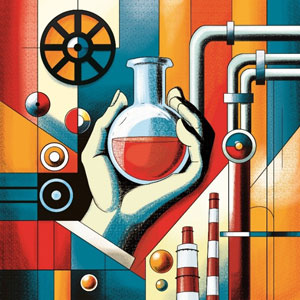
The Vargas Era deepened the separation between the intellectual and technical aspects of chemistry education, favoring the latter.
http://dx.doi.org/10.21577/1984-6835.20250062
Aprendizagem Baseada em Imagens (ABI) para Promover Habilidades de Pensamento Crítico dos Alunos e Resultados de Aprendizagem na Taxa de Reação
Mudzuna Quraisyah Basimin; Habiddin Habiddin  ; Ridwan Joharmawan; Yahmin Yahmin
; Ridwan Joharmawan; Yahmin Yahmin  ; Lutfiana Ufiqoh
; Lutfiana Ufiqoh
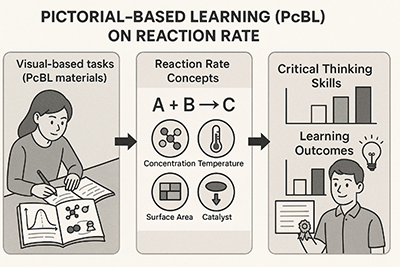
The figure explains how visual representations of reaction rate concepts were used as pictorial triggers to help students understand them. By analyzing the valuable information from these pictorial representations, students develop critical thinking skills through their firm grasp of the concepts.
http://dx.doi.org/10.21577/1984-6835.20250057
Redução de Óxido de Ferro: Uma Transformação Simples para Produzir Ferro Metálico a partir de Resíduo da Mineração de Ferro
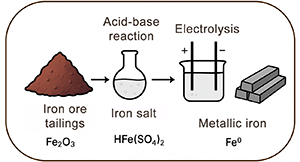
This work proposes a laboratory experiment for undergraduate students, demonstrating the transformation of iron ore tailings into metallic iron through an acid-base reaction and electrolysis process.
http://dx.doi.org/10.21577/1984-6835.20250052
Editoria da RVq - Editoria da RVq - PubliSBQ
Instituto de Química, Universidade Federal Fluminense,
Campus do Valonguinho, 24020-141, Centro, Niterói-RJ, Brasil
E-mail: rvq@sbq.org.br